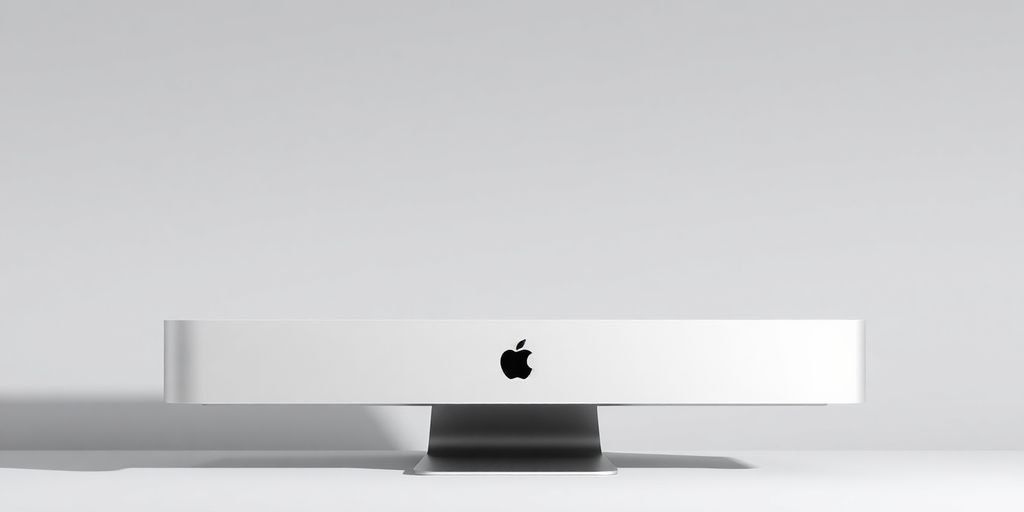Exploring the Power of Mac Computers with Apple Silicon: A New Era of Performance

In this article, we will explore the exciting world of Mac computers with Apple silicon. Apple has made a significant shift from Intel processors to its own ARM-based chips, which has changed the way these computers operate. With improved performance, efficiency, and user experience, Apple silicon is paving the way for a new era in computing. Let’s dive into the key takeaways that highlight the impact of this transition.
Key Takeaways
- Apple’s move to its own chips marks a big change in Mac computers with Apple silicon.
- The ARM architecture boosts performance and battery life, making Macs faster and more efficient.
- Software developers are adapting to this new technology to create better apps for Apple silicon.
- Users enjoy a smoother experience with macOS, thanks to optimizations for Apple silicon.
- The future looks bright for creative professionals as Apple silicon enhances tasks like video editing and graphic design.
Revolutionizing Computing with Apple Silicon
The Transition from Intel to Apple Silicon
The shift from Intel processors to Apple Silicon marks a significant change in how Macs operate. This transition allows Apple to design chips that are specifically tailored for their devices, leading to better performance and efficiency. The first chip, the M1, was a game changer, showcasing how Apple could integrate hardware and software seamlessly.
Benefits of ARM Architecture in Macs
Apple’s move to ARM architecture brings several advantages:
- Improved Performance: ARM chips are designed for high performance with lower power consumption.
- Better Battery Life: Users can enjoy longer usage times without needing to recharge.
- Enhanced Graphics: The integrated GPU provides stunning visuals for gaming and creative work.
Impact on Software Development
With Apple Silicon, developers are adapting their applications to take full advantage of the new architecture. This includes:
- Optimizing Apps: Many developers are updating their software to run natively on Apple Silicon.
- Creating Universal Apps: These apps work on both Intel and Apple Silicon Macs, ensuring compatibility.
- Leveraging New Features: Developers can utilize unique capabilities of Apple Silicon, such as the Neural Engine for AI tasks.
The introduction of Apple Silicon has not only changed the hardware landscape but also set a new standard for what users can expect from their Macs. Apple’s AI revolution is just beginning, and the potential is enormous!
Unmatched Performance and Efficiency
CPU and GPU Innovations
The new M4 chip in Mac computers brings incredible speed and power. With up to 10 CPU cores and a 10-core GPU, it can handle tasks much faster than previous models. For example, the MacBook Pro with M4 can render scenes up to 4 times faster than older Intel models.
Energy Efficiency and Battery Life
Apple Silicon is designed to be energy efficient, which means longer battery life for users. Here are some key points:
- Less power consumption while performing heavy tasks.
- Up to 20 hours of battery life on MacBook models.
- Efficient thermal management keeps the device cool without fans running all the time.
Real-World Performance Benchmarks
In real-world tests, the M4 chip shows impressive results. Here’s a quick comparison:
| Task | M4 MacBook Pro | Intel MacBook Pro |
|---|---|---|
| Scene Rendering (Maxon Redshift) | Up to 4x faster | Baseline |
| Gaming Performance (World of Warcraft) | Up to 13.3x faster | Baseline |
| DNA Sequencing (Oxford Nanopore) | Up to 23.8x faster | Baseline |
The M4 chip is a game changer, offering unmatched value and performance for both everyday users and professionals.
Overall, the combination of powerful CPUs and GPUs, along with energy efficiency, makes Apple Silicon a leader in performance and efficiency.
Enhancing User Experience with macOS

Optimizations for Apple Silicon
With the introduction of macOS Sequoia, the user experience on Mac computers has reached new heights. This version brings several optimizations specifically designed for Apple Silicon, enhancing speed and responsiveness. Key features include:
- iPhone Mirroring: Users can now interact with their iPhone apps and notifications directly on their Mac.
- Safari Highlights: Quickly access relevant information from websites, making browsing more efficient.
- Distraction Control: Hide disruptive elements on web pages for a cleaner browsing experience.
Seamless Integration with iOS
The integration between macOS and iOS has never been smoother. Users can enjoy:
- Drag and Drop Support: Easily transfer files between devices.
- Shared Notifications: Stay updated with alerts from both devices in one place.
- Unified App Experience: Many apps now work seamlessly across both platforms, enhancing productivity.
Security Enhancements
Security is a top priority with macOS Sequoia. New features include:
- Touch ID: Securely unlock your Mac and make purchases with a simple touch.
- Passwords App: Conveniently manage all your passwords and passkeys in one location.
- On-Device Processing: Protects user privacy while utilizing powerful features.
The advancements in macOS Sequoia not only improve performance but also create a more enjoyable and secure user experience.
Overall, macOS Sequoia represents a significant leap forward in enhancing the user experience on Mac computers, making them more powerful and user-friendly than ever before.
The Future of Creative Workflows
Advancements in Graphic Design
The new MacBook Pro with M4 Pro is changing the game for graphic designers. With its powerful hardware, it allows for faster rendering and smoother workflows. Designers can now:
- Create complex graphics in real-time.
- Use advanced software like Fusion and Luna Modeler without lag.
- Collaborate on projects seamlessly with cloud-based tools.
Video Editing Capabilities
Video editing has never been easier. The M4 Pro supports high-resolution video editing, making it ideal for filmmakers. Key features include:
- Up to 7.8x faster scene rendering with Maxon Redshift compared to older models.
- Enhanced performance in Final Cut Pro for editing 4K videos.
- Real-time playback of multiple video streams without stuttering.
Music Production on Apple Silicon
Music producers are also benefiting from the new MacBook Pro. The M4 Max model allows for:
- Faster audio processing and mixing.
- Support for more virtual instruments and effects.
- Improved performance in software like Logic Pro.
The M4 Pro supports up to 64GB of unified memory and 273GB/s of memory bandwidth, making it a powerhouse for creative tasks.
With these advancements, Apple Silicon is paving the way for a new era in creative workflows, allowing professionals to push their limits and achieve more than ever before.
Expanding the Mac Ecosystem

Compatibility with Existing Applications
Apple has made sure that the transition to Apple Silicon is smooth for users. Many existing applications run seamlessly on the new Macs. This compatibility is crucial for users who rely on specific software for their work. Most popular apps have been optimized to take full advantage of the new architecture, ensuring that users can continue their tasks without interruption.
Growth of the App Store
The App Store has seen a significant increase in new applications designed specifically for Apple Silicon. Developers are excited about the potential of the M-series chips, leading to a surge in innovative apps. Here are some key points about this growth:
- More apps are being developed for creative tasks.
- Gaming applications are becoming more advanced.
- Productivity tools are being enhanced for better performance.
Developer Opportunities
With the introduction of Apple Silicon, developers have new opportunities to create unique applications. The M-series chips offer powerful capabilities that can lead to:
- Faster development cycles due to improved performance.
- Enhanced user experiences with optimized software.
- Increased market reach as more users adopt Apple Silicon Macs.
The shift to Apple Silicon is not just a change in hardware; it’s a chance for developers to innovate and create applications that were previously unimaginable.
This expansion of the Mac ecosystem is a testament to Apple’s commitment to providing a robust platform for both users and developers alike. As the ecosystem grows, so does the potential for creativity and productivity on Mac computers.
Challenges and Considerations
Transitioning for Developers
The shift from Intel to Apple Silicon has not been without its hurdles. Developers face several challenges, including:
- Learning new tools: Adapting to new development environments and tools can be time-consuming.
- Updating existing applications: Many apps need to be recompiled or optimized for the new architecture.
- Testing and debugging: Ensuring that software runs smoothly on both Intel and Apple Silicon can complicate the development process.
Consumer Adoption and Feedback
As Apple Silicon gains traction, consumer feedback is crucial. Some key points include:
- User experience: Many users report improved performance, but some miss familiar Intel-based features.
- Learning curve: New users may find the transition challenging, especially if they are used to Intel Macs.
- Support and resources: Availability of support for new users is essential for a smooth transition.
Potential Limitations
While Apple Silicon offers many advantages, there are still some limitations to consider:
- Compatibility issues: Some older applications may not run well or at all on Apple Silicon.
- Hardware limitations: Certain hardware configurations may not be available immediately.
- Performance variability: Not all tasks may see the same performance improvements, especially in niche applications.
In summary, while Apple Silicon represents a significant leap forward, it also brings challenges that need to be addressed for a smooth transition.
Comparing Apple Silicon Macs to Competitors
Performance vs. Other ARM-Based Systems
When comparing Apple Silicon Macs to other ARM-based systems, the differences are clear. Apple’s chips, like the M1 and M2, have shown remarkable performance in various tasks. Here’s a quick look at how they stack up:
| Feature | Apple M1/M2 | Competitor ARM Chip |
|---|---|---|
| CPU Speed | Up to 3.2 GHz | Varies |
| GPU Cores | 8 | Varies |
| Battery Life | Up to 20 hours | Varies |
Price and Value Proposition
Apple Silicon Macs often come with a higher price tag, but they offer great value for the performance you get. Here are some reasons why:
- Longer lifespan due to optimized hardware and software integration.
- High resale value compared to other brands.
- Excellent customer support and ecosystem integration.
Market Impact
The introduction of Apple Silicon has changed the landscape of personal computing. Here are some key points:
- Increased competition in the ARM market.
- Encouraged other manufacturers to innovate.
- Shifted consumer expectations towards performance and efficiency.
Apple Silicon has not just improved performance; it has redefined what users expect from their computers. The seamless integration of hardware and software creates a unique experience that competitors struggle to match.
In summary, while Apple Silicon Macs may be pricier, their performance, efficiency, and overall value make them a strong contender in the market.
Conclusion
In conclusion, the arrival of Apple Silicon marks a significant change for Mac computers. With the new M4, M4 Pro, and M4 Max chips, users can expect faster speeds and better battery life. These advancements make Macs not just tools for work, but also creative partners for students, professionals, and anyone who values performance. Apple has shown that they are committed to improving user experience while keeping privacy in mind. As we move forward, it’s clear that Macs will continue to lead the way in technology, blending power and creativity in ways we have never seen before.
Frequently Asked Questions
What is Apple Silicon?
Apple Silicon is a series of chips designed by Apple for their Macs. These chips replace Intel processors, making Macs faster and more efficient.
How does Apple Silicon improve performance?
Apple Silicon chips use a different architecture called ARM, which allows them to perform tasks more quickly and use less energy than traditional Intel chips.
Can I run my old software on Apple Silicon Macs?
Most old software works on Apple Silicon Macs through a tool called Rosetta 2, which helps translate Intel apps to work on the new chips.
What are the benefits of using a Mac with Apple Silicon?
Macs with Apple Silicon offer better battery life, faster performance, and improved graphics, making them great for creative work and everyday tasks.
Is Apple Silicon only for Macs?
Currently, Apple Silicon is designed for Macs, but Apple also uses similar technology in their iPhones and iPads.
What should I consider before buying a Mac with Apple Silicon?
You should think about your software needs, how you plan to use the Mac, and whether the apps you use are compatible with Apple Silicon.








Responses